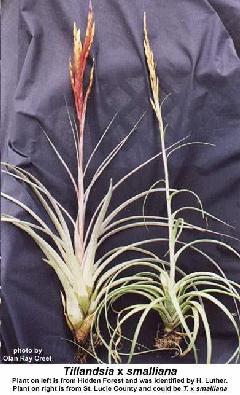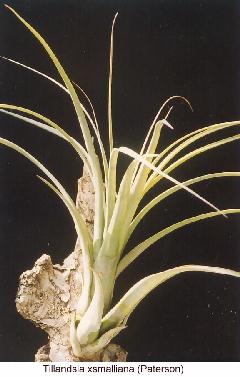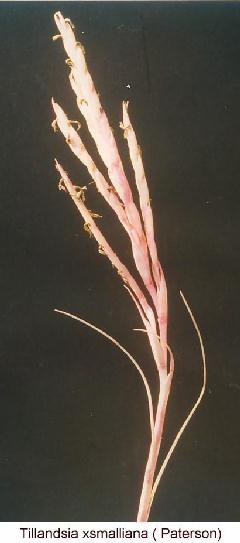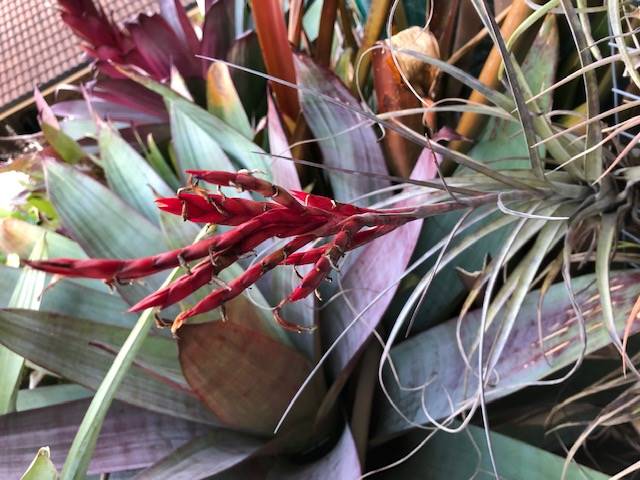



Plant stemless, flowering to 0.5 m high:
Leaves 8 to 18 in number, densely appressed lepidote throughout, stiff, coriaceous, arching but not at all recurved or contorted,
Sheaths broadly elliptic, inflated, to 4 cm wide,
Blades narrowly triangular, involute, to 2.2 cm wide at midlength;
Scape erect, exceeding the leaves:
Inflorescence digitate with 3 to 12 lateral, erect branches (rarely simple):
Primary bracts elliptic, glabrous, usually red:
Spikes 5 to 15 flowered:
Floral bracts densely imbricate, to 2.5 cm long, coriaceous, glabrous, red;
Sepals 2.0-2.4 cm long, posteriorly connate and carinate:
Corolla to 5 cm long, tubular, violet:
Stamens and style exserted:
Capsules to 3.8 cm long.
TYPE: United States, Florida. Collier Co., Big Cypress Swamp, Oct. 1980, Bush, Dragen, Determann & Luther s.n. (Holotype: SEL).
Additional material examined. United States; Florida; Palm Beach Co., Aug. 1960, C. Harris s.n.. (FLAS); Broward Co., 8 May 1960 D. B. Ward 1893 (FLAS); Monroe Co.. 18 Feb. 1930, H. N Moldenke 656 (NY): 22 Jan, 1955, Craighead & Mrazek 16 (US): 19 Dec. 1959 W. G. Atwater M.166 (FLAS); Dade Co., 2 June 1960, F. C Craighead s. n.. (FLAS): 8 Aug. 1963, R. Davis 563- SK (US).
Tillandsia X smalliana is frequently encountered in cypress swamps and in brightly lit hammocks throughout the southern portion of Florida (pers. obs.) always in the company of its putative parents T. balbisiana Schultes f. and T. fasciculata Sw. var. densispica Mez. All specimens examined are consistently intermediate, suggesting that these plants are primary hybrids and rarely backcross with either parent. Whether or not these hybrids are fertile has not been ascertained but they often develop fruit both in the wild and in cultivation.
Tillandsia X smalliana has usually been misdetermined as T. polystachia (L.) L., a common Caribbean species not known to occur in Florida. Luther (1978) has pointed out the differences between these two taxa and several other authors have expressed doubt concerning the identity and status of this Florida taxon (Smith, 1938; Rickett, 1966: C. S. Gardner,1982 and pers. comm: R, W. Read, 1984 and pers. comm.).
Tillandsia X smalliana may be distinguished from T. balbisiana by its more numerous leaves that are erect to arching and not at all recurved or contorted and larger inflorescence.
It differs from T. fasciculata by having its leaf-sheaths conspicuously inflated, a more slender scape, and narrower, more erect branches of the inflorescence.
Butcher's note – some of this "hybrid" taxa reproduce faithfully from seed.
Tillandsia x smalliana Luther. by Luther in J. Brom. Soc. 39(1): 24, fig 10 1989
The name Tillandsia polystachia has long been misapplied to a plant native to southern Florida. That plant is correctly named T. x smalliana, a natural hybrid of T. fasciculata and T. balbisiana. True T. polystachia, a very different appearing species, is widespread from the West Indies and Mexico to northern South America but is not native to Florida. The illustration below represents T. x smalliana and not T. polystachia. (see separate copy of drawing which is Foster 1140!) Collectors desiring the latter species should contact exporters in Mexico or Guatemala where it is abundant. The natural hybrid is rather infrequent and I hope that it will not be over-collected for commercial purposes.
From Smith in Phytologia 13(7): 454-5. 1966
TILLANDSIA BARTRAMII Ell. Bot. S. C. & Ga. 1: 379. 1817.
Tillandsia juncea sensu Leconte, Ann. Lyc. N. Y. 2: 130. 1826; Mez in DC. Mon. 9: 676. 1896, quoad pl. Florid., non Poir.
? Tillandsia pinifolia Leconte, Ann. Lyc. N. Y. 2: 131. 1826.
Tillandsia tenuifolia sensu Mez in DC. Mon. 9: 674. 1896; Small, F1. Se. U. S. 245. 1903, quoad syn. Tillandsia bartramii Ell.
Tillandsia simulata Small, Man. Se. Fl. 270, 1503, 1933.
Tillandsia myriophylla Small, Man. Se. Fl. 270, 1503. 1933.
UNITED STATES: GEORGIA: On old trees in the Mortar Swamp, Liberty County, Lewis LeConte s. n. (CHARL, holotype, phot. GH; NY, Isotype).
FLORIDA: Manatee River (Manatee County), June 1878, A. P. Garber s. n. (NY, lectotype of Tillandsia simulata Small; US, Isotype). Hammock south of Brooksville, (Hernando County), May 13, 1931, J. K. Small & E. J. Alexander s. n. (NY, type of Tillandsia myriophylla Small)
In the extreme southeastern United States, the group of species of Tillandsia subgenus Tillandsia with very narrow fasciculate leaves is extremely confused and confusing, and I fear that my efforts in the North American Flora in l938 did little to improve the situation. There, following previous authors, I misapplied T. juncea (R. & P.) Poir., a species that has a very densely digitate involucrate inflorescence and that ranges from Mexico and the West Indies to Peru and Bolivia. Up to the present, I have seen no authentic material of Tillandsia juncea from Florida.
It is possible to separate T. setacea Sw. (T. tenuifolia auctt., non L.) from the remainder of this complex on its leaves alone, which have very narrow sheaths, and blades that are thin, completely involute, strongly ribbed, and about 0.5 mm in diameter at mid-point (P1. I, fig. 1: Small & Mosier 5506), while those of the remainder are crescent-shaped in section and at least 1 mm in diameter at mid-point (p1. I, fig. 2: LeConte). T. setacea is limited to the southern half of Florida, while the remainder of the complex is rare there but common in the northern half and adjacent Georgia.
I have tried to find characters to separate the remainder of this complex both in the descriptions of Leconte and in those of Small and also independently, but so far in vain. The oldest name is T. bartramii Ell. and judging from the descriptions, T. pinifolia of LeConte belongs here, while his T. caespitosa appears to be a synonym of T. setacea. Types of two of Small's species have been located as indicated above, but T. hystricina remains a mystery with indications of relationship elsewhere because of the leaves with "stiff nearly knife-like tips".
In conclusion I should say that for some years research has been going on with the purpose of distinguishing entities in this complex, but until that is successful there is no choice but to use T. setacea and T. bartramii for the southern and northern species respectively.
From Luther in J. Brom. Soc. 28(4): 179. 1978
T. polystachya is usually cited as being native to the state of Florida. Smith (1938) has expressed doubt that it has ever been collected in Florida although he (Smith and Wood, 1975) subsequently included it in a listing of native bromeliads. The plant that is usually identified as this species is of uncertain taxonomic status but it has been suggested (Rickett, 1966) that it is a natural hybrid of T. fasciculata and T. balbisiana. This plant is fertile and apparently true breeding. In view of the uncertainties surrounding this local tillandsia, I propose that this taxon be provisionally known as Tillandsia 'Florida'.
The Florida plant differs from T. polystachya in the following characters: